Geography Playlist
19 chapters • 0 completed
The Universe and the Earth
18 topics
Atmosphere and its composition
6 topics
Atmospheric Temperature
11 topics
Atmospheric Moisture
9 topics
Air Mass, Fronts & Cyclones
15 topics
Evolution of Earths Crust, Earthquakes and Volcanoes
23 topics
Interior of The Earth
14 topics
Landforms
25 topics
Geomorphic Processes
10 topics
Movement of Ocean Water
16 topics
Oceans and its Properties
12 topics
Climate of a Region
14 topics
Indian Geography - introduction, Geology
5 topics
Physiography of India
27 topics
Indian Climate
20 topics
Indian Drainage
32 topics
Soil and Natural Vegetation
13 topics
Mineral and Energy Resources, Industries in India
28 topics
Indian Agriculture
22 topics
Chapter 5: Air Mass, Fronts & Cyclones
Chapter TestAir Mass
An air mass is a large body of air, extending over 1600 km or more, with uniform temperature and moisture. Its properties depend on the source region, which must have stable pressure and uniform topography.
An air mass is a large body of air, extending over 1600 km or more, with uniform temperature and moisture. Its properties depend on the source region, which must have stable pressure and uniform topography.
Air Mass Source Regions
| Type | Region | Nature |
|---|---|---|
| Continental (c) | Siberia, Sahara, Canada | Dry, stable |
| Maritime (m) | Atlantic, Pacific, Indian Ocean | Moist, unstable |
Mains Key Points
Prelims Strategy Tips
Modification and Classification of Air Mass
Air masses undergo modification when they move from their source regions, changing temperature and moisture. They are classified into maritime tropical, continental tropical, maritime polar, continental polar, and continental arctic types.
Air masses undergo modification when they move from their source regions, changing temperature and moisture. They are classified into maritime tropical, continental tropical, maritime polar, continental polar, and continental arctic types.
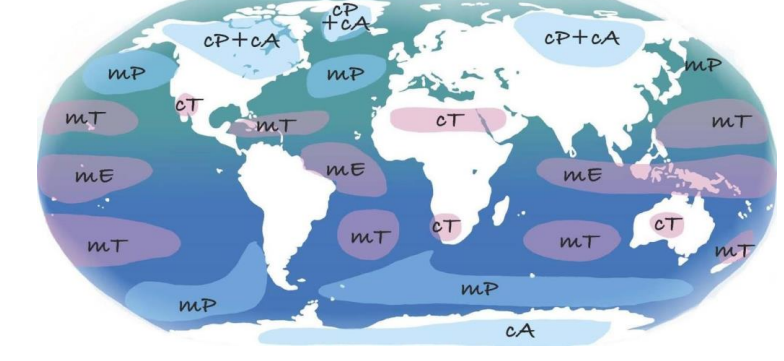
Types of Air Masses and Their Characteristics
| Air Mass | Source Region | Features | Weather |
|---|---|---|---|
| Continental Polar (cP) | Arctic basin, N. America, Eurasia, Antarctica | Dry, cold, stable | Winter: frigid, clear; Summer: less stable, warmer landmasses |
| Maritime Polar (mP) | Oceans between 40°–60° latitudes | Cool, moist, unstable | Winter: humid, cloudy, precipitation; Summer: fair and stable |
| Continental Tropical (cT) | Sahara, West Asia, Australia | Dry, hot, stable | Dry throughout the year, little precipitation |
| Maritime Tropical (mT) | Tropical oceans (Gulf of Mexico, Pacific, Atlantic) | Warm, humid, unstable | Winter: mild, cloudy; Summer: hot, humid, convectional rain |
| Continental Arctic (cA) | High Arctic interiors | Very cold, dry, stable | Extremely cold, clear conditions |
Mains Key Points
Prelims Strategy Tips
Fronts
Fronts are transitional zones between contrasting air masses, critical in shaping global weather. They form due to differences in temperature, pressure, and humidity. Fronts influence precipitation, storms, and mid-latitude cyclones, making them vital for weather forecasting.
Fronts are transitional zones between contrasting air masses, critical in shaping global weather. They form due to differences in temperature, pressure, and humidity. Fronts influence precipitation, storms, and mid-latitude cyclones, making them vital for weather forecasting.
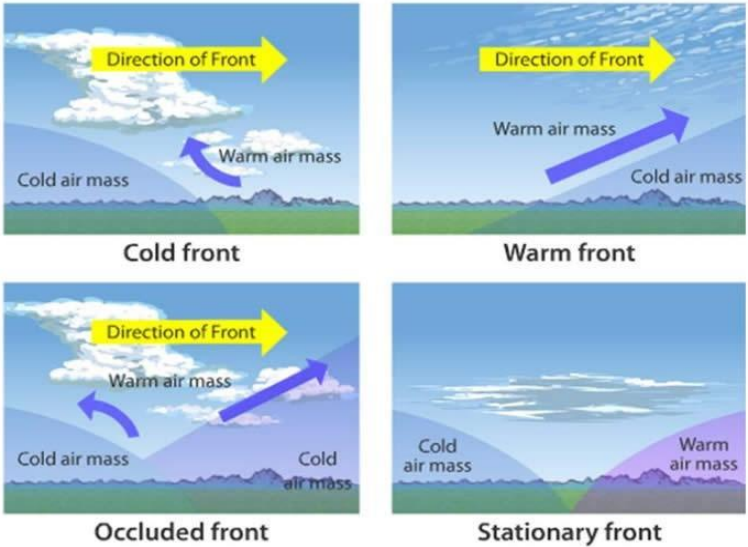
Types of Fronts and Associated Weather
| Front Type | Slope | Cloud Sequence | Weather |
|---|---|---|---|
| Stationary | Almost flat | Stratus, Nimbostratus | Persistent cloudiness, drizzle, fog |
| Warm | Gentle (1:100–200) | Cirrus → Cirrostratus → Altostratus → Nimbostratus | Steady widespread rain/snow |
| Cold | Steep (1:50–100) | Cumulus → Cumulonimbus | Heavy showers, thunderstorms, hail |
| Occluded | Variable | Mixed (cumulus + nimbus) | Erratic rain, stormy conditions |
Mains Key Points
Prelims Strategy Tips
Cyclones
Cyclones are large-scale low-pressure systems characterized by fast inward air circulation. They occur in both tropical and temperate regions and play a crucial role in global weather, rainfall, and climate. Cyclones can cause widespread destruction but are also vital for redistributing heat and moisture.
Cyclones are large-scale low-pressure systems characterized by fast inward air circulation. They occur in both tropical and temperate regions and play a crucial role in global weather, rainfall, and climate. Cyclones can cause widespread destruction but are also vital for redistributing heat and moisture.
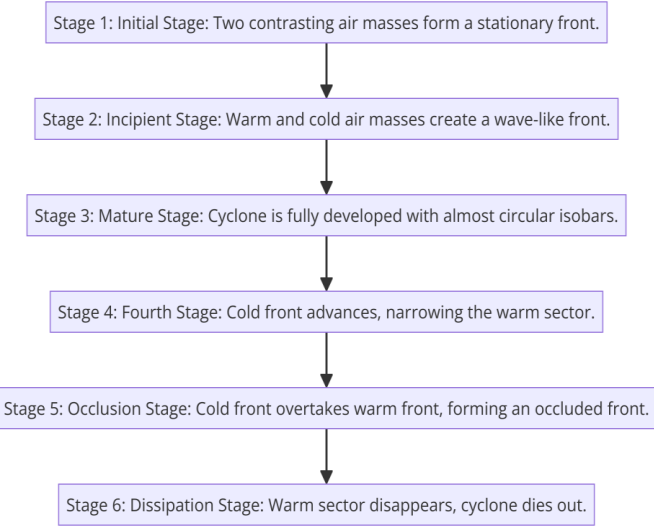
Comparison of Tropical and Temperate Cyclones
| Feature | Tropical Cyclone | Temperate Cyclone |
|---|---|---|
| Location | 5°–30° latitude over warm oceans | 35°–65° latitude, over land & sea |
| Size | 100–1000 km | 500–2000 km |
| Wind Speed | 120–250+ km/h | 30–80 km/h |
| Structure | Eye, eyewall, spiral bands | Frontal system (warm & cold fronts) |
| Movement | Westward & poleward | West to East |
| Duration | Few days to a week | Several days to weeks |
| Weather | Intense rain, storms, floods | Widespread rain, snow, cloudy weather |
Mains Key Points
Prelims Strategy Tips
Distribution of Temperate Cyclones
Temperate cyclones develop mainly along polar fronts where warm tropical air masses meet cold polar air masses. They are most common in mid-latitudes (35°–65°) across both hemispheres and strongly influence the weather of North America, Europe, Asia, and parts of the Southern Hemisphere.
Temperate cyclones develop mainly along polar fronts where warm tropical air masses meet cold polar air masses. They are most common in mid-latitudes (35°–65°) across both hemispheres and strongly influence the weather of North America, Europe, Asia, and parts of the Southern Hemisphere.
Major Regions of Temperate Cyclone Formation
| Region | Air Mass Interaction | Movement | Impact |
|---|---|---|---|
| Atlantic-Arctic Front | Warm Atlantic vs Cold Arctic | NE towards Europe | Rain, storms in Western Europe |
| North America Polar Front | Continental Polar vs Arctic | NE towards Canada & NE USA | Snowstorms, blizzards |
| Mediterranean-Caspian Front | Continental vs Warm Sea Air | East/Northeast | Western disturbances, winter rain in India |
| Southern Hemisphere | Marine Tropical vs Polar Air | SE | Storms in Chile, South Africa, Australia, NZ |
Mains Key Points
Prelims Strategy Tips
Tropical Cyclones
Tropical cyclones are violent storms originating in tropical oceans between the Tropic of Cancer and Tropic of Capricorn. They derive their energy from latent heat of condensation, move in spiral form, and cause large-scale destruction in coastal regions.
Tropical cyclones are violent storms originating in tropical oceans between the Tropic of Cancer and Tropic of Capricorn. They derive their energy from latent heat of condensation, move in spiral form, and cause large-scale destruction in coastal regions.
Regional Names of Tropical Cyclones
| Region | Name |
|---|---|
| Indian Ocean | Cyclone |
| Atlantic & Eastern Pacific | Hurricane |
| Western Pacific & South China Sea | Typhoon |
| Australia | Willy-Willies |
Mains Key Points
Prelims Strategy Tips
Distribution of Tropical Cyclones
Tropical cyclones occur in well-defined ocean basins across the world, especially over warm tropical waters. Their distribution is influenced by sea surface temperatures, Coriolis force, and seasonal variations. The North Pacific has the highest frequency globally, while the Indian Ocean cyclones are notorious for their destructiveness.
Tropical cyclones occur in well-defined ocean basins across the world, especially over warm tropical waters. Their distribution is influenced by sea surface temperatures, Coriolis force, and seasonal variations. The North Pacific has the highest frequency globally, while the Indian Ocean cyclones are notorious for their destructiveness.
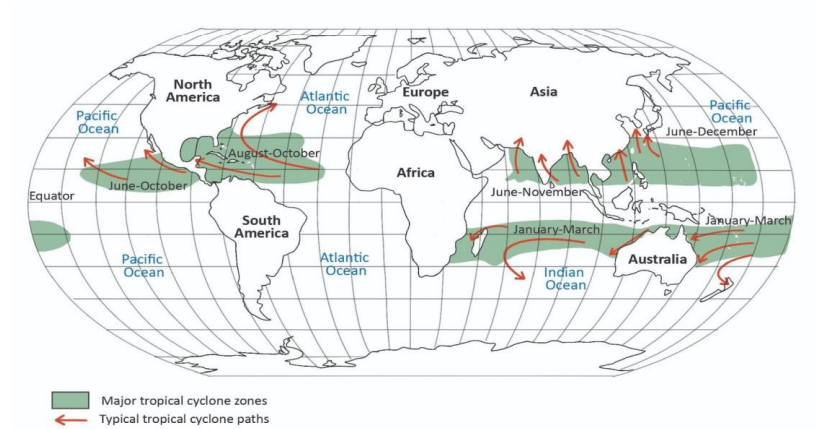
Global Distribution of Tropical Cyclones
| Region | Peak Season | Key Areas | Notes |
|---|---|---|---|
| North Atlantic | Aug–Oct | Caribbean, Gulf of Mexico, US Atlantic coast | Called Hurricanes |
| Indian Ocean | May, Oct–Nov | Bay of Bengal, Arabian Sea | Very destructive in South Asia |
| South Indian Ocean | Jan–Mar | Madagascar, Réunion, Timor Sea | Affects East Africa, NW Australia |
| North Pacific (East) | Aug–Oct | Mexico, Central America, California | Hurricanes in Eastern Pacific |
| North Pacific (West) | Aug–Sep | Philippines, S. China Sea, Japan | Highest cyclone frequency in the world |
| South Pacific (West) | Jan–Mar | Australia, Samoa, Fiji, Coral Sea | Summer cyclones common |
Mains Key Points
Prelims Strategy Tips
Structure and Life Cycle of a Tropical Cyclone
Tropical cyclones are intense low-pressure systems powered by latent heat of condensation over warm oceans. They consist of a central calm eye, a violent eyewall, and spiral rain bands. Their life cycle includes initiation over warm seas, intensification with a distinct eye, and dissipation after landfall. They play a dual role: redistributing heat and moisture, but also causing large-scale destruction.
Tropical cyclones are intense low-pressure systems powered by latent heat of condensation over warm oceans. They consist of a central calm eye, a violent eyewall, and spiral rain bands. Their life cycle includes initiation over warm seas, intensification with a distinct eye, and dissipation after landfall. They play a dual role: redistributing heat and moisture, but also causing large-scale destruction.
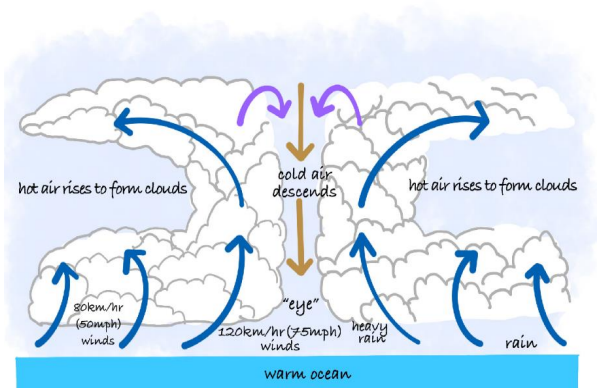
Structure of Tropical Cyclone
| Part | Key Features | Hazards |
|---|---|---|
| Eye | Calm, clear, lowest pressure, warm core | None, deceptively calm |
| Eye Wall | Most intense winds & rainfall, towering clouds | Catastrophic winds, storm surge |
| Rain Bands | Spiral cloud bands, heavy rainfall zones | Flooding, tornado-like vortices |
Life Cycle of Tropical Cyclone
| Stage | Features | Outcome |
|---|---|---|
| Early Stage | Warm ocean >27°C, rising moist air, Coriolis force | Depression forms |
| Mature Stage | Well-developed eye, eyewall, heavy rainfall, strong winds | Maximum destruction |
| Decay Stage | Landfall cuts moisture, friction increases, wind shear | System weakens & dissipates |
Mains Key Points
Prelims Strategy Tips
Types of Cyclones
Cyclones vary in intensity and structure, from weak tropical disturbances to devastating hurricanes. They develop under different oceanic and atmospheric conditions. A special type of cyclone, Medicanes, forms over the Mediterranean and shares similarities with tropical systems but is weaker and smaller.
Cyclones vary in intensity and structure, from weak tropical disturbances to devastating hurricanes. They develop under different oceanic and atmospheric conditions. A special type of cyclone, Medicanes, forms over the Mediterranean and shares similarities with tropical systems but is weaker and smaller.
Comparison between Tropical Cyclones and Medicanes
| Feature | Tropical Cyclones | Medicanes |
|---|---|---|
| Occurrence | Warm tropical waters (Atlantic, Pacific, Indian Oceans) | Relatively warm Mediterranean waters (temperate zone) |
| Wind Speed | High (118 km/h or more) | Low to moderate (up to ~100 km/h) |
| Size | Large (160–600 km diameter) | Smaller (70–200 km diameter) |
| Duration | Up to 1–2 weeks | Short-lived (1–3 days) |
| Energy Source | Latent heat from deep warm oceans | Shallow warm waters + baroclinic influences |
| Impact | Storm surge, floods, widespread destruction | Localized flooding, coastal wind damage |
Mains Key Points
Prelims Strategy Tips
Naming of Tropical Cyclones & Fujiwhara Effect
Tropical cyclones are named systematically by WMO regional bodies to avoid confusion and improve communication. An unusual phenomenon, the Fujiwhara Effect, occurs when two cyclones come close enough to interact, sometimes merging into a single powerful storm.
Tropical cyclones are named systematically by WMO regional bodies to avoid confusion and improve communication. An unusual phenomenon, the Fujiwhara Effect, occurs when two cyclones come close enough to interact, sometimes merging into a single powerful storm.
Fujiwhara Effect – Types of Cyclone Interaction
| Interaction Type | Description | Outcome |
|---|---|---|
| Elastic Interaction (EI) | Cyclones deflect each other's paths. | No merger, altered tracks. |
| Partial Straining Out (PSO) | Smaller storm loses part of energy. | Weakened smaller storm. |
| Complete Straining Out (CSO) | Smaller storm completely dissipates (if weaker). | Only stronger storm survives. |
| Partial Merger (PM) | Smaller storm merges partially into larger storm. | Larger storm intensifies slightly. |
| Complete Merger | Two storms of equal strength combine. | Formation of one powerful storm. |
Mains Key Points
Prelims Strategy Tips
Difference between Tropical and Temperate Cyclones
Tropical cyclones and temperate cyclones differ fundamentally in their origin, scale, energy source, and impact. While tropical cyclones are thermal systems fueled by latent heat over warm oceans, temperate cyclones are frontal systems formed by contrasting air masses in mid-latitudes.
Tropical cyclones and temperate cyclones differ fundamentally in their origin, scale, energy source, and impact. While tropical cyclones are thermal systems fueled by latent heat over warm oceans, temperate cyclones are frontal systems formed by contrasting air masses in mid-latitudes.
Comparison between Tropical and Temperate Cyclones
| Aspect | Tropical Cyclones | Temperate Cyclones |
|---|---|---|
| Emergence | Confined to tropics; smaller in area | Beyond tropics; larger in area |
| Origin | Thermal origin | Frontal origin |
| Formation | Require warm oceans (>27°C), latent heat of condensation, moisture | Form due to interaction of contrasting air masses; over oceans & land |
| Velocity | High, violent, destructive winds | Moderate wind velocity |
| Duration | Up to 7 days | 15–20 days |
| Impact | Storm surges, flooding, coastal destruction | Widespread rainfall, snow, frontal weather |
Mains Key Points
Prelims Strategy Tips
Anticyclones
Anticyclones are extensive high-pressure systems larger than mid-latitude cyclones, characterized by descending and diverging air. They bring stable weather conditions such as clear skies, dry air, and calm winds, but can occasionally lead to stagnation of air and pollution buildup.
Anticyclones are extensive high-pressure systems larger than mid-latitude cyclones, characterized by descending and diverging air. They bring stable weather conditions such as clear skies, dry air, and calm winds, but can occasionally lead to stagnation of air and pollution buildup.
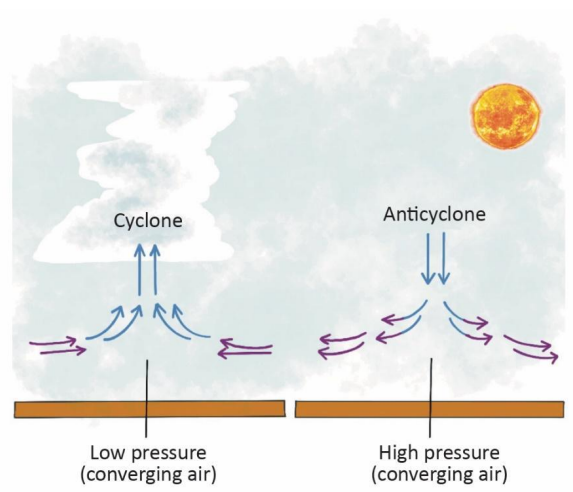
Difference between Cyclones and Anticyclones
| Aspect | Cyclones | Anticyclones |
|---|---|---|
| Pressure Center | Low pressure at center, surrounded by high pressure | High pressure at center, surrounded by low pressure |
| Wind Direction | Winds blow inward toward center | Winds radiate outward from center |
| Wind Nature | Violent and destructive | Mild and not destructive |
| Hemisphere Flow | Anticlockwise in NH, clockwise in SH | Clockwise in NH, anticlockwise in SH |
| Weather | Cloudy, thunderstorms, heavy rain | Calm, dry, clear skies |
| Impact | Associated with floods, storm surges | Associated with drought, fog, pollution stagnation |
Mains Key Points
Prelims Strategy Tips
Thunderstorms
Thunderstorms are intense atmospheric circulations associated with cumulonimbus clouds, characterized by strong upward air movement, heavy rainfall, lightning, thunder, and sometimes hail. They form rapidly, evolve in distinct stages, and significantly influence local weather patterns.
Thunderstorms are intense atmospheric circulations associated with cumulonimbus clouds, characterized by strong upward air movement, heavy rainfall, lightning, thunder, and sometimes hail. They form rapidly, evolve in distinct stages, and significantly influence local weather patterns.
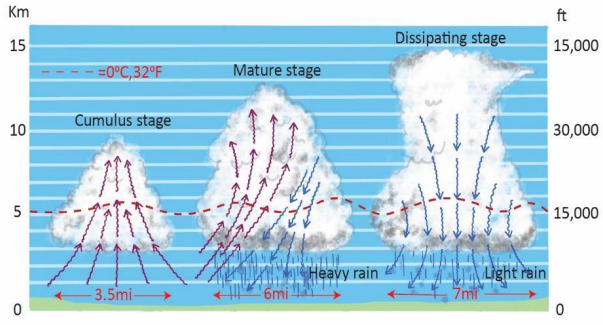
Life Cycle of a Thunderstorm
| Stage | Characteristics | Weather Impact |
|---|---|---|
| Cumulus | Strong updraft, cloud formation begins | Cloud build-up, no rainfall |
| Mature | Updraft + downdraft, intense convection | Heavy rain, hail, lightning, thunder |
| Dissipating | Downdrafts dominate, no vertical air movement | Clouds weaken, rainfall ends, clear skies follow |
Mains Key Points
Prelims Strategy Tips
Tornadoes
Tornadoes are funnel-shaped storms with extremely low pressure at the center and the strongest surface winds on Earth, capable of reaching up to 500 km/h. They occur mostly in middle latitudes during spring and summer, with the USA experiencing the most violent tornadoes.
Tornadoes are funnel-shaped storms with extremely low pressure at the center and the strongest surface winds on Earth, capable of reaching up to 500 km/h. They occur mostly in middle latitudes during spring and summer, with the USA experiencing the most violent tornadoes.
Tornadoes vs Waterspouts
| Feature | Tornadoes (Land) | Waterspouts (Sea) |
|---|---|---|
| Location | Over land (plains, valleys, storm-prone regions) | Over warm tropical oceans/seas |
| Wind Speed | Can exceed 400–500 km/h | Generally weaker (<150 km/h) |
| Appearance | Funnel-shaped cloud touching the ground | Rotating water column extending from clouds to sea |
| Impact | Destruction of settlements, infrastructure, crops | Dangerous to ships, boats, and coastal regions |
| Frequency | High in USA, Bangladesh, Argentina | Frequent in tropical oceans, Caribbean, Mediterranean |
Mains Key Points
Prelims Strategy Tips
Lightning
Lightning is a natural electrical discharge caused by charge separation within cumulonimbus clouds. It occurs when negative charges at the bottom of clouds connect with positive charges at the top or on the ground, producing a sudden flash of light and immense energy release.
Lightning is a natural electrical discharge caused by charge separation within cumulonimbus clouds. It occurs when negative charges at the bottom of clouds connect with positive charges at the top or on the ground, producing a sudden flash of light and immense energy release.
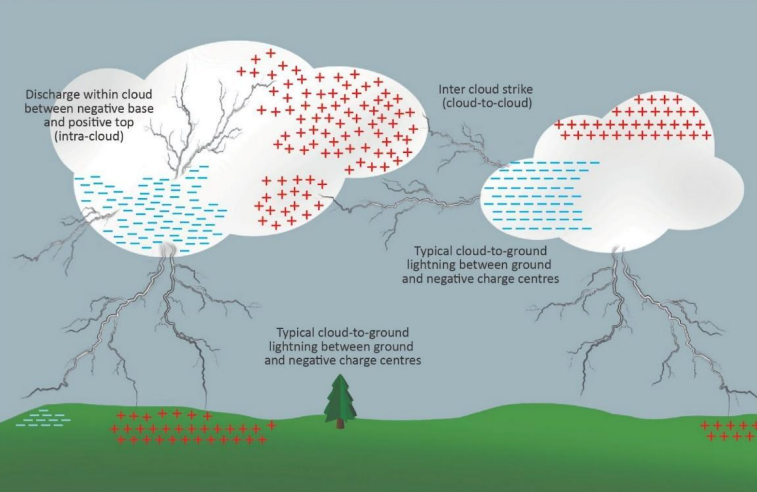
Types of Lightning
| Type | Description | Danger Level |
|---|---|---|
| Cloud-to-Ground (CG) | Lightning strike between cloud and ground | Very High |
| Intra-Cloud (IC) | Within one cloud | Low |
| Cloud-to-Cloud (CC) | Between two clouds | Medium |
| Ball Lightning | Rare glowing ball of lightning | Unpredictable |
| Heat Lightning | Silent lightning from distant storms | Negligible |
Mains Key Points
Prelims Strategy Tips
Chapter Complete!
Ready to move to the next chapter?
